Few cars have captured the public imagination or established a niche for a manufacturer as well as the original Quattro did for Audi. Indeed, now, the term quattro (with lower case ‘q’) is applied to any Audi with an all-wheel drive system. This, though, is the car that started it all for the Ingolstadt outfit.
Interest in the Quattro has been revived of late with the reveal of the TT RS, which has a punchy five cylinder turbo, just like the original. Both cars had their first public reveal at the Geneva Motor Show—the Quattro in 1980, the TT RS in 2009.
The Quattro was built from 1980 until 1991 and had three engine variations during that time. All featured the famous inline five cylinder turbocharged configuration, starting with a 2144cc 10v (1980–87), before getting a minor tweak to 2226cc (1987-89), which also improved low down torque. The final revision (1989-91) took the engine to a 20-valve DOHC setup, while keeping capacity at 2226cc.
While the road car in itself was something of a revolution, it was on the world rally stage that the Quattro really shook things up. Audi’s new technical masterpiece was able to exploit Group B regulations to their maximum, with the benefits of all-wheel drive pioneered by Audi leaving its rivals eating dust.
Like the road cars, the rally going Quattro received a number of updates throughout its life. Starting with the comparatively tame looking A1, A2 and Sport Quattro evolutions which helped bring back-to-back World Rally Championship success to Audi in 1983 and 1984. The follow up to these cars was the wild aero kitted Sport Quattro S1. In 1986 at the peak of their development the car was believed to have a power figure as high as 441kW (approx 600bhp). This is still considered to be the most powerful WRC car of all time.
The Audi factory team pulled out of WRC part way through the 1986 season, but the car continued to gain notoriety through its efforts at the famous Pikes Peak International Hill Climb in Colorado. Audi won the event three times on end from 1985 to 1987. This included world record times to Michèle Mouton (1985) and Walter Röhrl (1987).
To reflect on the Quattro one has to look past its awkward proportions and boxy shape and simply admire the technical prowess the car possessed. The Quattro has left a lasting legacy for Audi and the World Rally Championship.
To help further appreciate this legacy there are a number of images, YouTube clips and a few press releases from the Audi archives to boot. You might also like to check out the Ur-Quattro’s Wikipedia page for further detail.
UPDATE 4 April: A brief article on the Quattro appears in Issue 7 of Road Magazine.
The first-ever quattro
The ‘original quattro’
Ingolstadt, 2005-02-22 “We wanted to create the impression of a car that’s ‘glued to the ground’ – with capability rather than elegance in the foreground. And this formal concept has justified itself as effective, correct and credible.†These were the terms in which Hartmut Warkuss, who was head of design at that time, later described the first quattro. Derived from the Audi 80 Coupé, but with sharp-edged body styling, it was presented to journalists on March 3, 1980 at an indoor ice-skating rink close to the exhibition ground at which the Geneva Motor Show was being held.
The new five-seater coupé had a compact 2,524 mm wheelbase and an overall length of 4,404 mm. It ran on 6-inch forged alloy wheels supplied by the Fuchs company. Dr. Ferdinand Piëch was well aware of the fact that with this car he was writing a new chapter in automobile engineering. His speech concluded with the words: “Today sees the première of all-wheel drive for the roadgoing passenger car.â€
The epoch-making quattro – the name was Walter Treser’s idea – was enthusiastically received: its revolutionary driveline concept and sporty character convinced the journalists immediately. The five-cylinder turbocharged and charge-air intercooled engine, with a displacement of 2,144 cc, developed 147 kW (200 bhp) at the maximum boost pressure of 0.85 bar and reached its maximum torque of 285 Nm at an engine speed of 3,500 rpm. The quattro weighed 1,290 kilograms and could sprint from 0 to 100 km/h in 7.1 seconds and reach a top speed of over 220 km/h. Its permanent traction, firm, sporty suspension settings and functional interior design revealed this new model to be an out-and-out ‘driving machine’.
The quattro took its place at the top of the manufacturer’s programme for that model year – not only in terms of its high performance, but also of its selling price: 49,900 German marks. Despite this considerable sum, sales figures rocketed when the first cars reached the showrooms in November 1980. In the first two full years of the car’s production cycle, almost 2,000 left the N 2 individual assembly building in Ingolstadt. The first 400 were needed as evidence that the Group 4 world rally championship regulations had been complied with.
The ‘original quattro’, as its fans now call it, remained in production until 1991; during this period 11,452 cars were built. In the first few production years the interior became steadily more sophisticated in its materials, but there were also a few minor technical changes, for example digital displays and speech-output warnings, the anti-lock braking system and running-gear modifications. An update was carried out in the autumn of 1987, and bestowed the Torsen centre differential and a slightly larger five-cylinder engine on the quattro: the new power unit retained the original power output of 147 kW (200 bhp), but developed greater low-speed torque. In 1989 the power output was raised to 162 kW (220bhp) by installing a new four-valve cylinder head; the top speed increased to 230 km/h.
A special model in the quattro programme appeared in 1984, and still enjoys a legendary reputation: this was the Sport quattro with the wheelbase reduced to a mere 2,204 mm and a newly developed four-valve turbocharged engine with an aluminium cylinder block; this had a power output of 225 kW (306 bhp). Although nominally a roadgoing car, extensive use of Kevlar and other weight-saving materials confirmed that this special model was also a serious rally contender. 224 of this ‘short version’, as it was known, were built, and enabled Audi to homologate its rally entries in Group B. The purchase price, too, was high enough to ensure more than a modicum of exclusivity: 203,850 German marks.
Walter Röhrl triumphed at Pikes Peak 20 years ago
quattro hits the heights
- Convincing victory in 1987 in Colorado with Sport quattro S1
- 19.99 kilometres, 156 corners, with over 600 bhp
- Audi won the famous hill-climb race three years running
Ingolstadt, 2007-07-11 Of the many rally victories recorded by Audi in the 1980s, the last one was particularly memorable: 20 years ago, on 11 July 1987, Walter Röhrl and his Audi Sport quattro S1 won the Pikes Peak Hill Climb in the US state of Colorado.
Following Audi’s withdrawal from the World Rally Championship in the previous year, this success marked the seamless transition of “Vorsprung durch Technik†into series production. After the company retired from rallying, quattro technology continued its success story on the road – Audi has sold 2.5 million cars with permanent four-wheel drive up to the present day.
Walter Röhrl and Audi, the best driver and the most successful rallying team at that time, enjoyed a close and always extremely intensive relationship. Röhrl, the world champion of 1980 and 1982, had joined the Ingolstadt team in 1984 at a time when the brand with the four rings dominated the entire rallying scene. The permanent four-wheel drive system left the rear-wheel-drive competitor vehicles with no chance whatsoever. A mere two years after first testing the Audi quattro at the end of 1980, Audi had already clinched the manufacturers’ world title. The Finn Hannu Mikkola won the drivers’ world championship in 1983, and in the following year Audi took both titles, with Stig Blomqvist from Sweden topping the drivers’ rankings.
From 1984 Audi’s rivals – Peugeot, Lancia, MG and Ford – also featured four-wheel drive to compete against the brand’s new racing car, the Sport quattro, whose wheelbase had been reduced to 222 centimetres. The regulations of what was then Group B imposed few restrictions in terms of technology; the fierce competition resulted in engines which generated over 370 kW (around 500 bhp). The supercar era ended in 1986; Audi withdrew from the World Championship.
In order to acquaint the US public, too, with the “art of engineering†(the slogan in the USA), Audi had entered the world’s best-known hill-climb race for the first time in 1984 – the “Race to the Clouds†on Pikes Peak in Colorado.
4,301 metres high, it is in the Rocky Mountains and is named after the explorer Zebulon Montgomery Pike, who charted it by order of the US army. The first race was staged in 1916, and subsequently took place on a regular basis, generally on the national holiday, 4 July. At the start of the 1980s the organisers introduced a category for rallying cars – an ideal stage for high-tech brands such as Audi.
The Pikes Peak track is unique. The International Hill Climb, as the race is officially known, takes place in an environment where mountain racers feel at home. It starts at a height of 2,866 metres at Crystal Creek, and the route to the summit is 19.99 kilometres in length with an average upward gradient of seven percent.
156 corners without guardrails
The winding track, which has 156 corners and leads through areas of bare rock, largely consists of reddish sand and gravel under which is a solid clay surface. The track is six metres wide on the straights and up to 15 metres wide in the corners; there are no guardrails. In the upper section, the track winds its way along sharp ridges like the edge of a table; at the “Bottomless Pit†there is an abyss 1,800 metres deep.
Just as in the World Rally Championship, Audi also enjoyed great successes right from the start on Pikes Peak. In 1984 Michèle Mouton from France came second in the Audi Sport quattro, despite being slowed down by a minor defect; in the following year she won the race. In 1986, the American motor-racing legend Bobby Unser set a new record in his Sport quattro S1 with a time of 11:09:22 minutes.
The S1, with which Röhrl took part as the only Audi driver in 1987, was a high-tech driving machine of pure, maximised functionality. The 2.1-litre five-cylinder engine, installed longitudinally at the front of the vehicle, had a nominal power output of some 440 kW (around 600 bhp) at 8,000 rpm and 590 Nm of torque at 5,500 rpm. At the top of Pikes Peak the power output actually available would have been approximately 330 kW (around 450 bhp).
A circulating-air system continuously maintained boost pressure in the large KKK K28 turbocharger, crucially improving the turbocharger’s response in the thin mountain air. When the throttle was closed, the charge air shot into the exhaust, where it was reheated with the exhaust gas, keeping the turbine revs up.
The power of the five-cylinder engine was transmitted via a six-speed gearbox, which even then used the dual-clutch principle – a pioneering feat by Audi – on a quattro driveline equipped with three locking differentials. The four 16-inch wheels, fitted with Michelin tyres, were mounted on double wishbones. On Pikes Peak, where the route almost always led upwards, Audi used a small and correspondingly light brake system.
Weight-optimised in all areas and converted into a one-seater, the Audi Sport quattro S1 weighed a mere 1,000 kilograms or so on its appearance in Colorado. The outer skin consisted of sheet steel and plastics, and was built on a tubular space frame. Powerful wings at the front and rear, developed in the wind tunnel, kept the angular body pressed down towards the ground; there were even wide air deflectors on the sides of the car.
Röhrl dominated right from day one
Walter Röhrl, the reserved perfectionist, was a virtually unknown European as far as American racing fans were concerned, and was taking part at Pikes Peak for the first time. But the dominance with which he took control of proceedings from the outset was evidence of his exceptional talent.
Despite extensive preparations, the Peugeot team, with Jean Todt at the helm, only made an impression in qualifying: when there was an electronic fault in the circulating-air system of Röhrl’s car, Ari Vatanen (Finland), the strongest of the three Peugeot drivers, took advantage to record the best time in his 205 T16.
On 11 July 1987, the day of the race, the organisers made the drivers start the race in the reverse order of their results in qualifying. Vatanen brought up the rear of the field, with Röhrl one place in front of him. The man from Regensburg, always calm and collected at the wheel, conquered the world’s most elevated highway in a new world record time of 10:47:85 minutes. He reached sixth gear in the S1 on four occasions, and at the quickest point of the track was measured at a speed of 196 km/h. Röhrl took each of the 156 corners with razor-sharp precision and performed full power-slides around the hairpin bends; sometimes the edge of the car was actually hanging over the precipice.
Ari Vatanen lost the duel, completing the course in 10:54:38 minutes, almost seven seconds slower than Röhrl. Peugeot cited a broken hose clamp and resulting boost pressure problems. Only in the following year – Audi having withdrawn from the Pikes Peak race after achieving a hat-trick of victories – did Vatanen succeed in winning, this time at the wheel of a Peugeot 405.
Walter Röhrl was emotional and happy following his victory, and seemed close to tears. He later stated: “All I can say is that it was great to take part. It was crazy, but often it is in fact the crazy things which are the best in life. It was the very pinnacle of what can be done with a rally car.â€
Outstanding success on the road
Röhrl and Audi continued to work together for several more years, with the double world champion taking on an advisory role, helping the brand to continue quattro technology’s outstanding success on the road. Starting from as early as 1982, Audi had incorporated five more four-wheel-drive models into its range in addition to the legendary Ur-quattro of 1980. In 1988 followed the Audi V8, with quattro drive as standard, which broke new ground with its V8 engine generating 185 kW (250 bhp). In its racing-car form it won the German Touring Car Masters – yet further proof of the quattro principle’s supremacy in motorsport.
From 1990 onwards the S models, all of which were also fitted with quattro drive, played their part in further enhancing the brand’s image of cultivated sportiness. Audi then introduced a model series with even more pronounced levels of dynamism – the RS line. And since 1995 the powerful TDI diesel models are also available with quattro drive – another harmonious combination.
In 1999 the four-wheel-drive principle made its way into the compact class. The power produced by the transversely installed engine was distributed by an electronically controlled Haldex transmission unit in the Audi A3, Audi TT and Audi TT Roadster. And then in 2003 the TT featured the innovative DSG dual-clutch gearbox with what was in principle the same technology which had paved the way for Walter Röhrl to conquer Pikes Peak. A further innovation made its debut in 2005 on the Audi RS 4. The new generation of mechanical Torsen differentials features asymmetric/dynamic torque distribution; the flow of power in the ratio 40:60 between the front and rear wheels allows for even sportier driving.
There are two figures which illustrate the outstanding success of quattro technology particularly well: Audi, the worldwide market leader for premium-class passenger cars with four-wheel drive, currently has no less than 84 four-wheel-drive variants in its model range. And from 1980 to today, the brand has produced 2.5 million cars with quattro drive.
Audi Tradition at the Techno Classica 2005
25 years of quattro
Ingolstadt, 2005-03-16 Four rings, seven letters, 25 years: Audi Tradition is presenting the unique success story of quattro drive at the 17th Techno Classica Essen from 7 to 10 April 2005 with the exhibition “25 years of quattroâ€. The “Ur-quattro†(original quattro) was the highlight at the Geneva Motor Show a quarter of a century ago. This car was the start of a legend, the beginning of a series of successes in motorsport and on the road which has lasted up to the present day. Over 1.8 million Audi cars with “quattro†permanent four-wheel drive have left the production line since 1980.
Every year, collectors, restorers and enthusiasts make their way to Essen for the international classic car exhibition, which marks the start of the new classic car season. Rally enthusiasts and Audi fans are in for a real treat this year: in Hall 7 they will find the rally racing cars once driven by Michèle Mouton, Stig Blomqvist, Hannu Mikkola and, of course, Walter Röhrl – all washed and polished. These were the drivers who wrote a new chapter in rallying history with the Audi quattro in the 1980s, the highlight of which were four world championship titles.
The following production quattro models and their racing and rallying counterparts will be on show:
Audi quattro, built in 1981 (147 kW/200 bhp):
11,452 of the “Ur-quattroâ€, as this car is known, were built between 1980 and 1991.
Audi Rallye quattro, Group 4 rally car, built in 1981
(237 kW/320 bhp at 6,500 rpm):
From 1981 the Audi quattro turned the rally world upside down. This Rallye quattro made its debut appearance with Hannu Mikkola/Arne Hertz in October 1981 at the San Remo Rally. In November these two drove this car to victory in the RAC Rally in Great Britain.
Audi Sport quattro, built in 1984 (225 kW/306 bhp):
A total of 214 Audi Sport quattro models were produced between 1983 and 1984.
Audi Sport quattro S1, Group B rally car, built in 1985 (350 kW/476 bhp at 7,500 rpm):
The Sport quattro S1 was the last evolution version of the Rallye quattro. The front “snow plough apron†and the mighty rear wing became the S1’s trademarks. Walter Röhrl and Christian Geistdörfer won the 1985 San Remo Rally in the Sport quattro S1.
Audi 200 quattro “James Bondâ€, built in 1986 (134 kW/182 bhp):
This car was produced specially for the James Bond film “The Living Daylights†starring Timothy Dalton and could be seen at cinemas in 1987.
Audi 200 quattro, Group A rally car, built in 1987 (184kW/250 bhp
at 6,000 rpm):
In 1987, the Rally World Championship was only held in Group A. In this year Audi clinched a double win in the challenging Safari Rally with its teams Mikkola/Hertz and Röhrl/Geistdörfer.
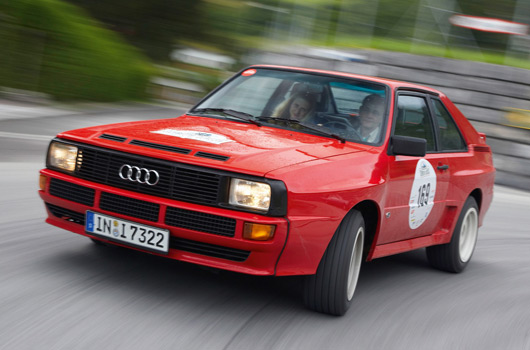
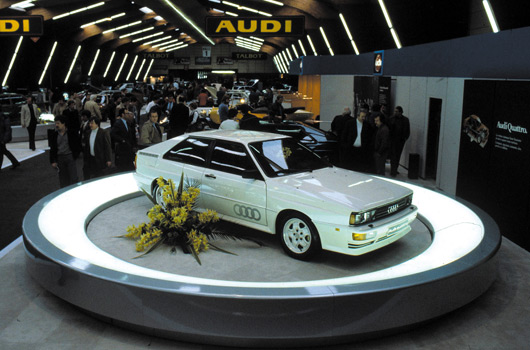
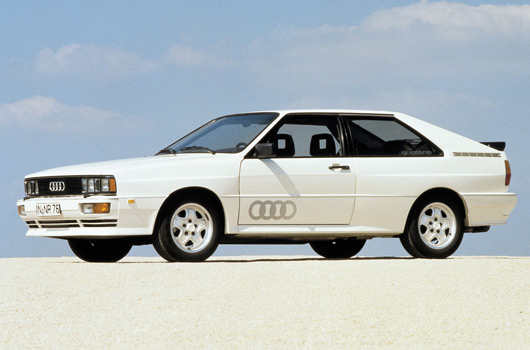
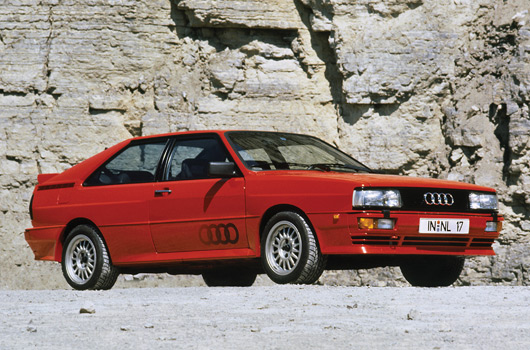
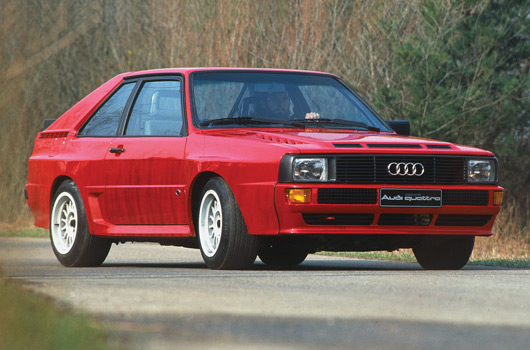
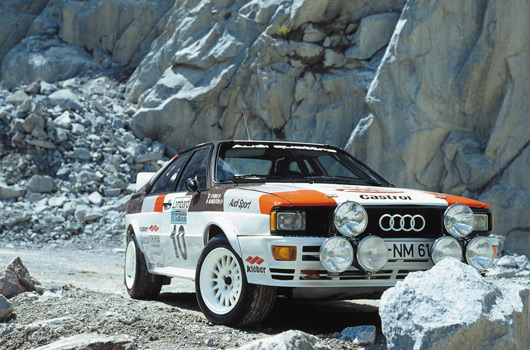
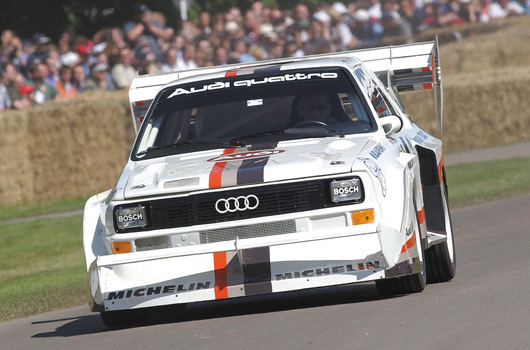
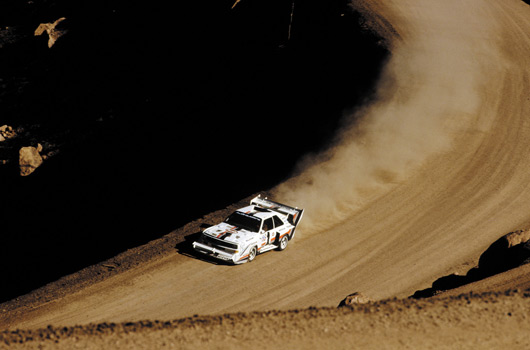
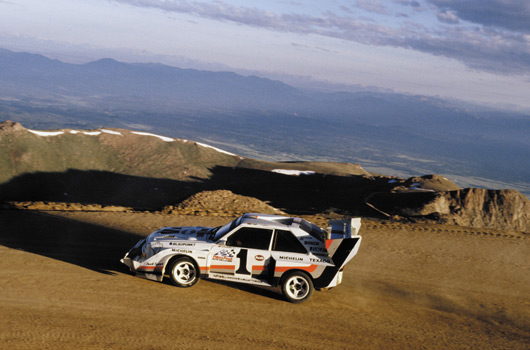
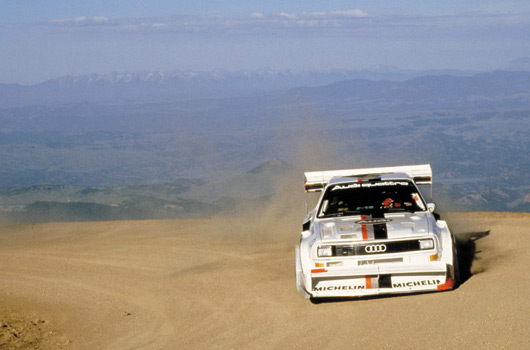
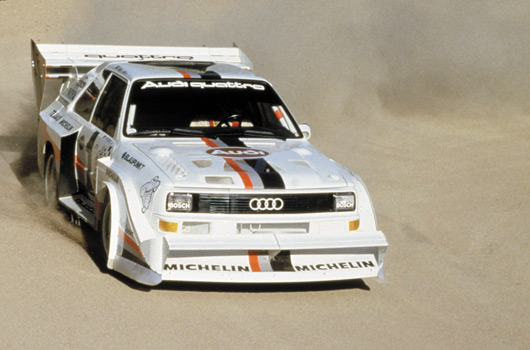
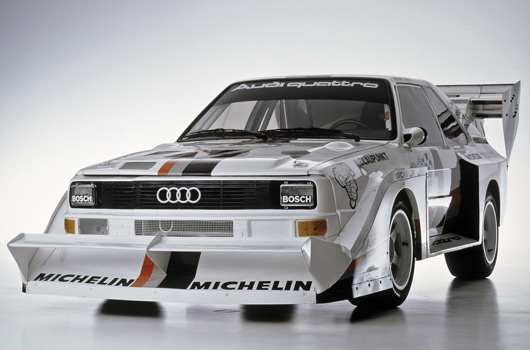
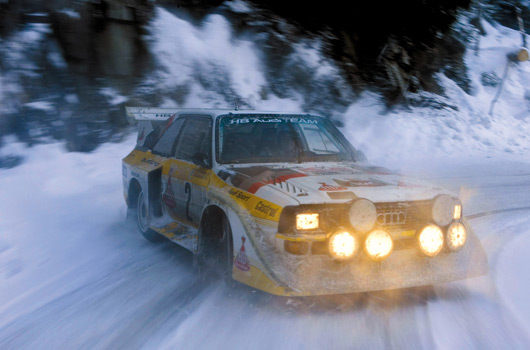
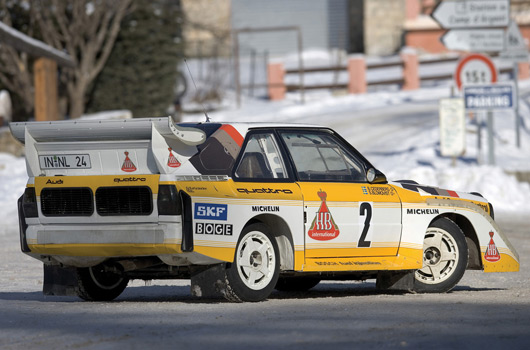
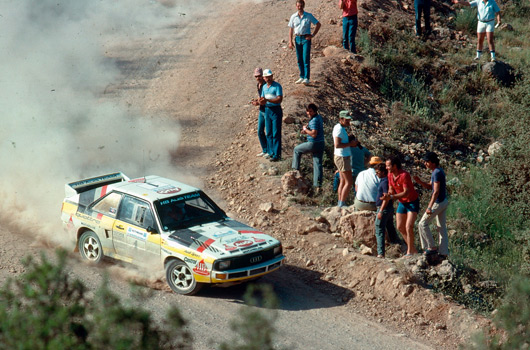
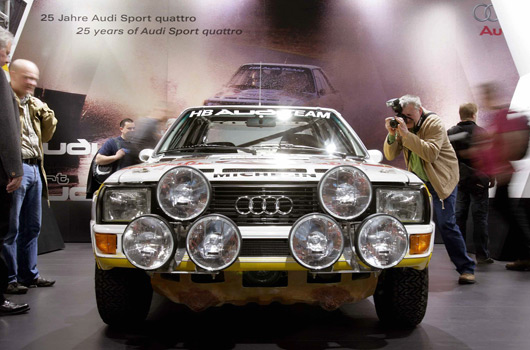
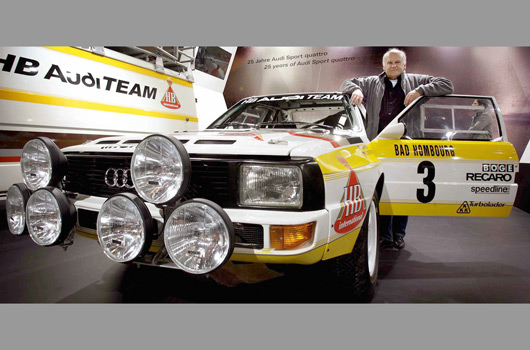
21 replies on “Past master: Audi ‘Ur-Quattro’”
Wow … great article, and even better car here.
No matter how many times you see the footage you never get sick of seeing the S1 Evolution painting four black lines whist going down hill.
I grew up on Group B and remember years ago reading a story about Walter finishing a stage in the quattro and finding a human finger wedged into one the the side mirrors.
Haha, that’s awesome in a gruesome kind of way!
It’s unfathomable today how they ever let rallying go ahead with the amount of crowds that used to be on the roads.
[…] you enjoyed AUSmotive’s Past Master piece on Audi’s seminal Ur-Quattro, then you will most likely get a kick out of this seemingly odd […]
[…] According to CAR magazine you’re looking at the Audi Project Anniversario. A new model based on the S5 that breathes new life into the car that put Audi on the modern performance map—the iconic Ur Quattro. […]
http://www.youtube.com/watch?v=buFt5UKayEU
http://www.youtube.com/watch?v=LoN_fV5qRJk
[…] TouTube clip here from DTMEnthusiast. Not so much DTM goodness here, though. No, it’s mostly Quattro rally footage, with a bit of circuit racing just so we don’t forget Audi doesn’t mind […]
[…] bit into two and half minutes, the highlight being Walter Röhrl at the wheel of his Pikes Peak Quattro […]
[…] more on the original Quattro check out the AUSmotive past master feature. As well, you can read Audi’s extensive press release below which covers the both the history […]
[…] your favourite all-paw Audi over the years? The obvious choice for many would be the original, the Ur Quattro shown above. For me, it would have to be the awesome RS2. That’s the car that piqued my […]
[…] just under 10 minutes and takes us through the origin of the famous Audi drivetrain, seen in the Ur Quattro, right up to the different applications we see in today’s road cars. It’s a nice […]
[…] is 30 years since Audi first released the original Quattro. And it now turns out that camouflaged machine we saw a couple of weeks ago is this new quattro […]
[…] for a look at an old rally legend now, with the Audi Quatrro. It’s a car we’ve featured in our Past Master series and we’re always keen to see new […]
[…] some excellent video of a truly great Audi Quattro S1 replica from Bulgaria. The back to the future rally weapon was made by ProSpeed from a road going […]
[…] chosen to look back at their motorsport heritage, starting, of course, with the Ur-Quattro rally cars, before culminating with their latest Le Mans […]
[…] Now we’re hearing the Quattro, codenamed Q35, will be released in 2015 with as many 10,000 models built per year. A worthy launch date for the Q35 could be March 2015, the 35th anniversary of the Ur Quattro. […]
[…] credit — AUSmotive dot com – F1 Fanatic dot com – Carsfolia dot […]
[…] aces Hermann Müller and the real Stig—Stig Blomqvist—and given them a new Audi S3 and an old Ur-Quattro to play with. The result is predictable and presented in a manner that lacks the inspiration and […]
[…] in the world of rallying before coming to life on public roads with models such as the legendary Ur Quattro and the devastatingly quick RS2 […]
[…] great philosophers once said, “You can’t stop progress”—we hope these videos of “The S1″ absolutely smashing it will appease those who aren’t happy with Audi’s […]